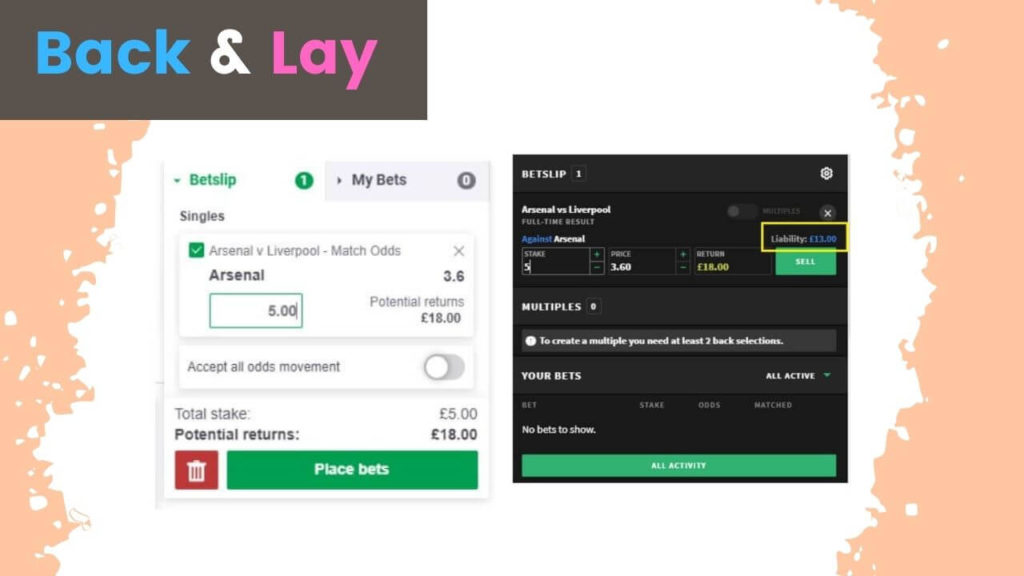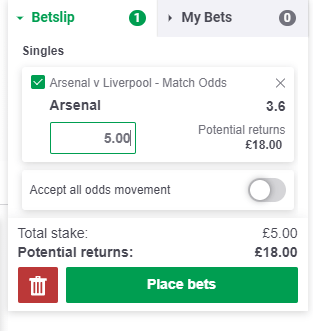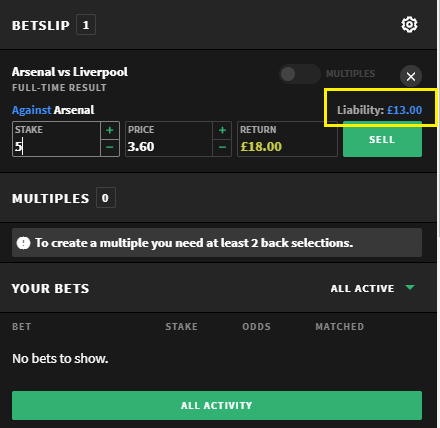What Are Back Bets And Lay Bets
In this article, I will talk you through the definition of both a back bet and a lay bet. Both types of bets are nice and easy to understand. It is important for a matched bettor to have a good understanding of how they both work.
What is a Back Bet?
As matched bettors, we only place back bets with bookmakers.
A back bet is a conventional type of bet everyone is likely to have heard of. Simply put, placing a back bet refers to betting a certain amount of our own money on a horse or football team to win at an event in the hopes of winning more money back from the bookmaker if they do.
Here is an example of a typical back bet.
As you can see in the above example, I am placing £5 of my own money on Arsenal to win the football match, should they do so I will expect a return of £18 from the bookmaker (£5 of that being from my original stake). Should Arsenal not win the match meaning my back bet loses I will have lost my back stake of £5 to the bookmaker.
- My Risk: £5
- Bookmakers Risk: £13
What is a Lay Bet?
As matched bettors, we only place lay bets with betting exchanges.
A lay bet is the opposite of a back bet. Lay betting is the act of placing some of your own money on a horse or a football team to not win at that particular event. Therefore, we would lose our liability from the lay bet if the horse or football team that we bet against actually went on to win that event. Alternatively, we would win extra money from the lay stake if that horse or football team did not go on to win.
Note: A lay bet will cover a football team or a horse (or whatever you are placing a lay bet on) to not win at that event, this will include a draw. A lay bet is strictly placing your money on something to not win at an event.
Here is an example of a typical lay bet.
This time I have done the complete opposite of what I did with my back bet. I placed a £5 lay bet on Arsenal to not win their football match. If Arsenal does not win (including if they draw) my lay bet is a winner and I get to keep the lay stake of £5. Alternatively, Arsenal could win this match, if they do my lay bet will be a loser I must pay out £13 of liability.
- My Risk: £13
- Back Bettors Risk: £5
What Is The Difference Between a Back Bet And a Lay Bet
The difference between the 2 types of bets is very simple to understand as they are just the opposites of each other.
If we were to place a £5 back bet on Arsenal to win with a bookmaker at odds of 3.6 (just like in the back bet example earlier) we would expect a return of £18 if our back bet won. Our return would be the initial £5 back stake plus an additional £13 from the bookie.
Back stake (5) X back odds (3.6) = £18
Now, If we were to do the opposite and place a £5 lay bet on Arsenal with a betting exchange at odds of 3.6 (just like in the lay bet example) our position would now be reversed. Placing this lay bet would effectively mean that we are taking a fellow exchange users back bet on the same event, this also happens to be the same situation the bookmaker was in with me when I placed a £5 back bet with them earlier.
What this means is that we effectively take the role of a bookmaker when we place a lay bet, we take someone else’s £5 back bet who is looking for Arsenal to win their match at odds of 3.6. We are able to keep their £5 stake should Arsenal lose the match. However, if our lay bet losses meaning Arsenal win their match we would then need to pay out the back bettor our liability as they have won their bet and we have lost ours.
Our exchange liability (money at risk) is calculated using the below formula.
Back stake (5) X back odds (3.6) – Back Stake (5) = £13
Click Here to View Our Liability Guide.
Conclusion
To conclude, I have left a screenshot of both the earlier examples below, as you can see they are essentially mirror images of each other. When placing a back bet we are risking our back stake to win the bookmaker’s liability. When we place a lay bet we are risking our liability in order to win the back bettors stake.



